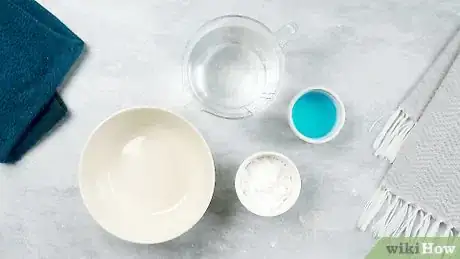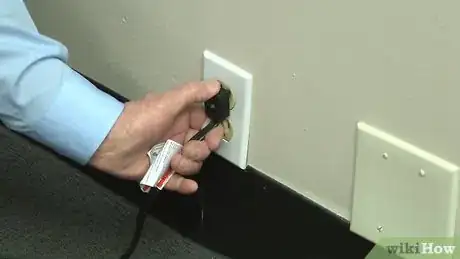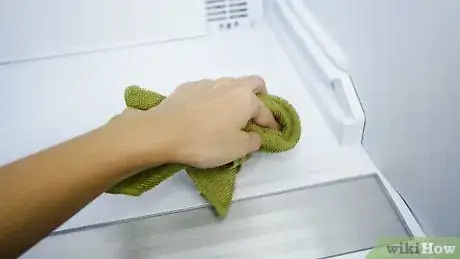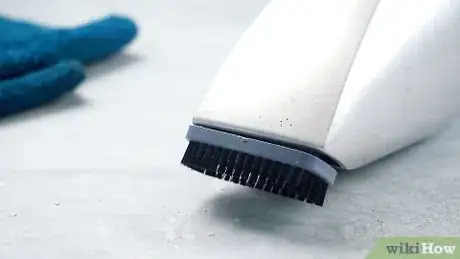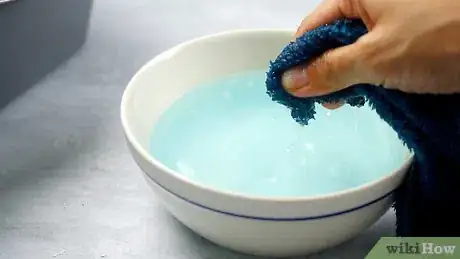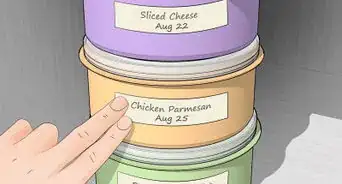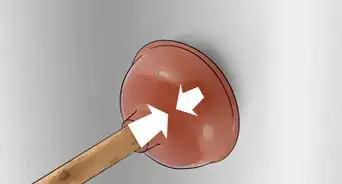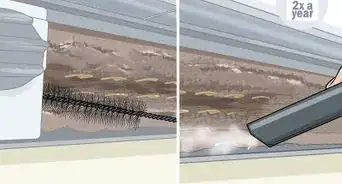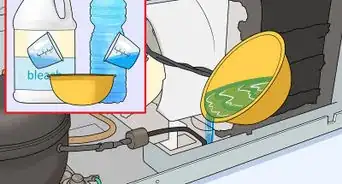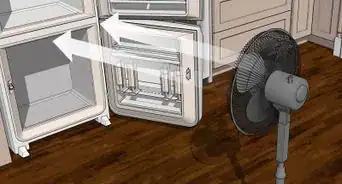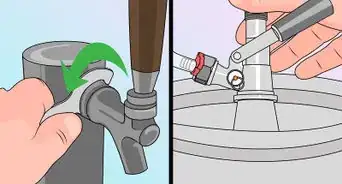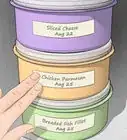This article was co-authored by Aaron Beth and by wikiHow staff writer, Jennifer Mueller, JD. Aaron Beth is the founder of Aaron’s Refrigeration Company in New York City and a factory certified installer (FCI) for Sub-Zero products. He specializes in the service and maintenance of built-in refrigerators, wine coolers and ice machines. With over 54 years of experience, Aaron is the recipient of numerous Super-Service awards from Angie’s Lists and 2019 Best-of-the City.
There are 8 references cited in this article, which can be found at the bottom of the page.
wikiHow marks an article as reader-approved once it receives enough positive feedback. This article received 19 testimonials and 100% of readers who voted found it helpful, earning it our reader-approved status.
This article has been viewed 750,264 times.
Your fridge is probably the largest appliance in your kitchen, but you probably don't give much thought to cleaning it like you do your countertops and other surfaces—unless you spill something. But a clean fridge is more energy-efficient and will last longer, so make the effort at least once a year (more often if there's food residue inside). Cleaning this hulking appliance can be an intimidating task, so we've gathered answers to your most common questions about how to get it done right.[1]
Steps
Expert Q&A
-
QuestionWhy does the front of the fridge get so dirty at the bottom?
 Aaron BethAaron Beth is the founder of Aaron’s Refrigeration Company in New York City and a factory certified installer (FCI) for Sub-Zero products. He specializes in the service and maintenance of built-in refrigerators, wine coolers and ice machines. With over 54 years of experience, Aaron is the recipient of numerous Super-Service awards from Angie’s Lists and 2019 Best-of-the City.
Aaron BethAaron Beth is the founder of Aaron’s Refrigeration Company in New York City and a factory certified installer (FCI) for Sub-Zero products. He specializes in the service and maintenance of built-in refrigerators, wine coolers and ice machines. With over 54 years of experience, Aaron is the recipient of numerous Super-Service awards from Angie’s Lists and 2019 Best-of-the City.
Appliance Technician That's where the condenser is. What happens is that anything in front of your fridge ends up getting sucked into the grate there. It can get especially dirty for people who have pets.
That's where the condenser is. What happens is that anything in front of your fridge ends up getting sucked into the grate there. It can get especially dirty for people who have pets. -
QuestionHow often do I need to clean my refrigerator coils?
 Aaron BethAaron Beth is the founder of Aaron’s Refrigeration Company in New York City and a factory certified installer (FCI) for Sub-Zero products. He specializes in the service and maintenance of built-in refrigerators, wine coolers and ice machines. With over 54 years of experience, Aaron is the recipient of numerous Super-Service awards from Angie’s Lists and 2019 Best-of-the City.
Aaron BethAaron Beth is the founder of Aaron’s Refrigeration Company in New York City and a factory certified installer (FCI) for Sub-Zero products. He specializes in the service and maintenance of built-in refrigerators, wine coolers and ice machines. With over 54 years of experience, Aaron is the recipient of numerous Super-Service awards from Angie’s Lists and 2019 Best-of-the City.
Appliance Technician It depends on where you live, but the general rule of thumb is to do it twice a year. That's probably a safe estimate for most people.
It depends on where you live, but the general rule of thumb is to do it twice a year. That's probably a safe estimate for most people. -
QuestionHow do I get the sticky marks, left by sticky labels, off my new fridge?
 wikiHow Staff EditorThis answer was written by one of our trained team of researchers who validated it for accuracy and comprehensiveness.
wikiHow Staff EditorThis answer was written by one of our trained team of researchers who validated it for accuracy and comprehensiveness.
Staff Answer wikiHow Staff EditorStaff AnswerAny kind of oil (such as mineral oil, vegetable oil, or baby oil) should break down the adhesive so you can wipe the residue off. Then, clean the area with a cloth dipped in soapy water.
wikiHow Staff EditorStaff AnswerAny kind of oil (such as mineral oil, vegetable oil, or baby oil) should break down the adhesive so you can wipe the residue off. Then, clean the area with a cloth dipped in soapy water.
Warnings
- If food in your fridge spoils or is recalled, clean your fridge after you dispose of it. Germs could spread to other parts of your fridge and infect other food.[17]⧼thumbs_response⧽
References
- ↑ https://www.bhg.com/homekeeping/house-cleaning/tips/how-to-clean-a-refrigerator/
- ↑ https://www.bhg.com/homekeeping/house-cleaning/tips/how-to-clean-a-refrigerator/
- ↑ https://www.cdc.gov/foodsafety/pdfs/5-steps-to-clean-your-refrigerator.pdf
- ↑ https://www.bhg.com/homekeeping/house-cleaning/tips/how-to-clean-a-refrigerator/
- ↑ https://www.bhg.com/homekeeping/house-cleaning/tips/how-to-clean-a-refrigerator/
- ↑ https://www.bhg.com/homekeeping/house-cleaning/tips/how-to-clean-a-refrigerator/
- ↑ https://www.bhg.com/homekeeping/house-cleaning/tips/how-to-clean-a-refrigerator/
- ↑ https://www.bhg.com/homekeeping/house-cleaning/surface/how-to-clean-stainless-steel/
- ↑ https://www.southernliving.com/kitchen-assistant/why-you-should-clean-refrigerator-door-gaskets
- ↑ https://www.bobvila.com/articles/how-to-clean-refrigerator-coils/
- ↑ https://www.familyhandyman.com/project/how-to-avoid-refrigerator-repairs/
- ↑ https://www.samsung.com/africa_en/support/home-appliances/recommended-way-to-remove-sticker-residue-from-a-refrigerator/
- ↑ https://www.cdc.gov/foodsafety/pdfs/5-steps-to-clean-your-refrigerator.pdf
- ↑ https://www.goodhousekeeping.com/uk/house-and-home/household-advice/a684998/how-clean-is-your-fridge/
- ↑ https://www.familyhandyman.com/project/how-to-avoid-refrigerator-repairs/
- ↑ https://www.bhg.com/homekeeping/house-cleaning/tips/how-to-clean-a-refrigerator/
- ↑ https://www.cdc.gov/foodsafety/pdfs/5-steps-to-clean-your-refrigerator.pdf
About This Article
To clean your refrigerator, first take everything out of it and store it in the freezer or a cooler filled with ice packs. Then, pull out any removable drawers and shelves, and scrub them clean using a sponge and hot, soapy water. Scrape off stubborn grime with a wooden spatula or toothpick. Rinse the shelves and drawers and let them air dry. Next, fill a spray bottle with 2 parts water and 1 part white vinegar, and spray the inside of your fridge. Wipe down the interior with a cloth, then use a new cloth to wipe the vinegar away. Finally, place any drawers and shelves back in the fridge and restock all of the food. To keep your newly-cleaned fridge smelling fresh, leave an open container of baking soda in it, which will absorb bad odors. To learn more about how to clean the interior parts of your fridge, like the coils and fan, keep reading!
